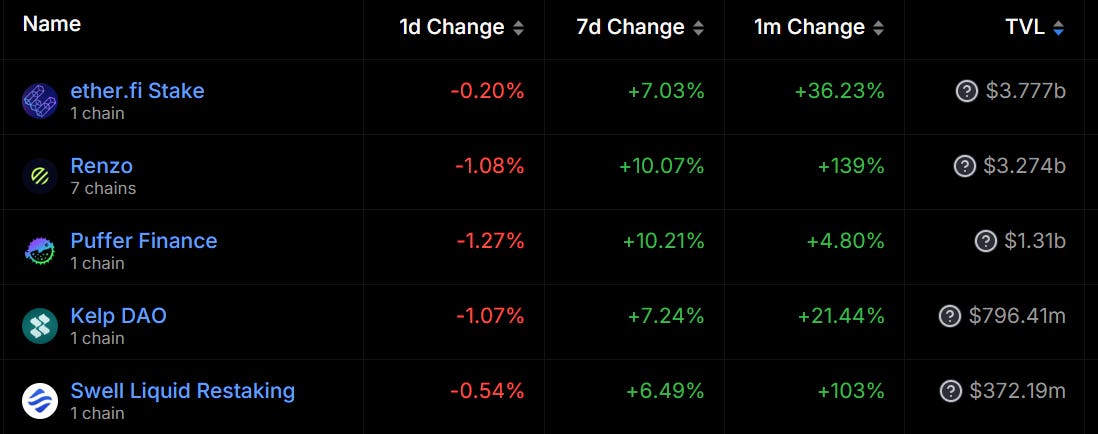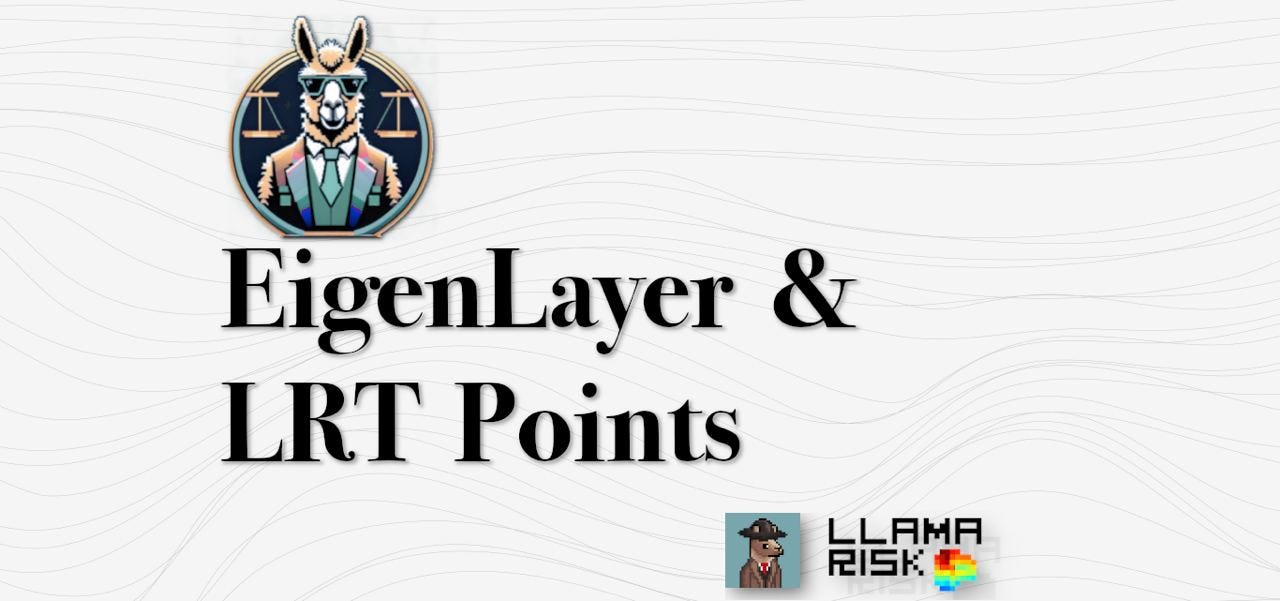Introduction
EigenLayer (EL), a pioneering protocol constructed atop the Ethereum blockchain, introduces "restaking" as an innovative mechanism to bolster crypto-economic security. This feature allows participants to stake Ethereum directly or through liquid staking tokens, thereby extending cryptographic security measures to various projects within the Ethereum ecosystem.
EigenLayer's restaking mechanism offers an appealing opportunity for users to achieve higher yields compared to traditional staking methods. By engaging in restaking, users can obtain enhanced returns as compensation for assuming the additional risks linked with potential slashing penalties. Currently operating in a tokenless mode, EL provides users with EL Points as a measure of their contribution.
Restaked points represent a notable development in the context of high-yield expectations from EigenLayer. The points concept has spurred widespread interest in accruing potential rewards from an anticipated EigenLayer airdrop. This phenomenon has not only influenced existing liquid staking protocols to devise reward schemes but has also led to the emergence of new platforms centered around enhancing points accumulation.
The trend towards farming potential EigenLayer airdrops has brought multiple projects into the limelight. The following five Leading protocols are on our radar due to their deep interconnectedness with EigenLayer and their presence across various farming strategies.

This article aims to scrutinize protocols' points programs alongside EigenLayer's reward structure to illuminate the legal considerations for users engaging with these entities (hereafter referred to as "program operators"). It is crucial to clarify that our analysis does not constitute legal or investment advice but seeks to aid in the assessment of counterparty risks associated with these protocols.
NB: As of the date of this review, among the discussed protocols, only ether.fi has carried out an airdrop. The eligibility criteria for the ETHFI token airdrop were based on the extent of each user's engagement with the protocol, both prior to and during the first season of eth.fi campaign. A forthcoming second season is confirmed, featuring an additional airdrop where any ETHFI tokens unclaimed in season 1 will be returned to the protocol's treasury and reallocated for use.
Legal Risk Checklist
When engaging with points programs, one should consider the legal details around them. A clear definition of points and their incorporation in the Terms of Use, for instance, clarifies the nature of the rewards and the conditions governing user participation. Knowledge of the formula for allocating points ensures that users can verify the fairness and transparency of the protocol. Awareness of potential revocation rules and transferability restrictions informs users about their rights and limitations, affecting how they earn, retain, and utilize their points. Understanding the elements below aids users to accurately gauge the nature of their engagement, the benefits they might accrue, and the obligations they undertake.
1. Definition and Terms
Definition: Is there a clear definition of points or analogous rewards within the program?
EL: Points are described as "a measure of your contribution to the shared security of the EigenLayer ecosystem" directly correlating with the "time-integrated amount staked".
ether.fi: The documentation lacks a formal definition of loyalty points, despite providing detailed descriptions of their functionality.
Renzo: Points are defined as rewards for "users who contribute to the success of the protocol".
Puffer: A clear definition of points within either Puffer documentation or its quest portal is not present.
Kelp - Kelp Miles are designed to "help Kelp understand user contribution" and "define the proportion of distributing rewards later".
Swell - Pearls are explicitly linked to the distribution of SWELL token airdrops, representing "a share of the SWELL token airdrop".
Terms of Use: Are points covered in the terms and conditions, including references to external rules governing the program?
EL: Absent from Terms of Service.
ether.fi: Pursuant to the Terms of Use through interaction with ether.fi services users can earn points, which do not hold any inherent value in real currency, do not constitute the personal property of the user, nor are they treated as currency or a medium of exchange. Points are also non-redeemable, non-refundable, and non-convertible into any form of currency or other value.
Renzo: Aspects of the points program are discussed across various sections of the documentation, these details are not formally integrated into the Terms of Service.
Puffer: Terms lack coverage of points or other reward references.
Kelp: The methodology for defining and distributing Kelp Miles is outlined in the Gitbook, yet these details are absent from the Terms of Service.
Swell: No specific mention within the Terms of Service. Information regarding Pearls is relayed through website articles.
The examination of points systems reveals a consistent trend: the critical details governing these points are often situated outside of formal Terms of Service agreements. The lack of explicit ToS coverage may leave participants without clear guidance on the rights, obligations, and remedies related to their restaked points, potentially complicating legal interpretations of their value and use within the ecosystem.
2. Calculation and Distribution
Calculation: What formula is used to allocate points?
EL: EigenLayer points are calculated based on the time-integrated amount of tokens staked, reflecting a user's contribution to the EigenLayer ecosystem's security. The calculation involves integrating the staked token amount over time, treating all tokens equivalently, and expressing the total in ETH⋅hours. The total participation measure for a staker is the sum of measures for each token held. The restaked ratio compares a staker's participation measure against the aggregate measures of all stakers.
ether.fi: Loyalty points are calculated based on the amount of ETH staked. For every 0.001 ETH staked, user received 1 point per day in season 1, whereas season 2 introduces a 10x boost (e.g. same ETH amount earns 10 points a day).
Renzo: Employs a specific formula where ezETH holders earn one Renzo ezPoint per hour per ezETH held. Additional incentives include boosts for early participation and multipliers for engaging in various DeFi activities like DEX liquidity provision and lending market supplies.
Puffer: Details on the calculation of points are not provided in Puffer's available information.
Kelp: Kelp Miles are calculated based on the formula: (Amount of rsETH) x Number of days x 10,000. The formula helps to quantify a user's contribution to Kelp by considering the amount of rsETH they hold and the duration they hold it for, thereby defining the distribution of rewards
Swell: N/A
Distribution: How are points earned and under what conditions?
EL: Does not disclose specific actions beyond staking that would result in the allocation of additional rewards.
ether.fi: Outlines a variety of activities through which users can earn loyalty points, including staking ETH or liquidity provisioning. Importantly, the accumulation of loyalty points is contingent upon holding specific assets (eETH, weETH) or engaging with designated ecosystem paths.
Renzo: Along with the conventional earning modes (minting and holding ezETH), the protocol allows for deposit boosts (e.g., 100 points per 1 ETH deposit until a specified date) and a referral system offering a 10% bonus of the referred user's earned points.
Puffer: Does not reveal details about the activities that lead to points being earned.
Kelp: Employs a detailed mechanism for accruing points, with regular Kelp Miles based on the amount and duration of rsETH held, and additional opportunities through special campaigns and boosted rewards for early participation.
Swell: Specifies concrete actions for earning Pearls, including minting and depositing swETH on EigenLayer, with bonuses and normal rates for restaking swETH.
3. Revocation and Transferability
Revocation: Can points be revoked by the program operator?
EL: Not specified
ether.fi: Violations of ToS such as unauthorized transfers may lead to the points being voided.
Renzo: There are rules against 'looping'—the practice of repeatedly using the same ezETH to generate rewards. Such activity is closely monitored, and detection of looping can lead to the revocation of points and boosts.
Puffer: Not specified
Kelp: Not specified
Swell: Not specified
Transferability: Are points transferable between users?
EL: Not specified
ether.fi: Points are strictly non-transferable, prohibiting users from sublicensing, trading, selling, or attempting to sell them for money or other considerations, or exchanging them for any external value.
Renzo: Not specified
Puffer: Not specified
Kelp: Not specified
Swell: Not specified
The absence of clear revocation policies necessitates a cautious approach from users, as it may imply that points are subject to change or removal at the discretion of the program operators.
Ether.fi's restriction on points transferability introduces a clear boundary on the use and circulation of loyalty points. For other platforms, the lack of specification on transferability leaves a gray area that could complicate users' ability to fully leverage their points.
4. Value
The valuation of points, beyond their role as indicators for future airdrops, remains opaque, with neither EigenLayer nor affiliated teams disclosing their application towards governance initiatives. This ambiguity challenges the classification of points as crypto-assets, particularly in light of their potential non-transferability and undefined value representation.
5. Regulatory Compliance
The public offering of points is identifiable through any communicative means providing information about the program. Traditional exemptions applicable to offerings limited to qualified or institutional investors do not apply in this context. User motivation to accumulate points, driven by the prospect of favorable positions in future airdrops, underscores the necessity to evaluate points within the regulatory frameworks of the program operator’s jurisdiction. Moreover, the laws of jurisdictions where the programs are marketed or protocol activities occur must also be considered.
Program operators may face enforcement actions if authorities determine that they are facilitating unregistered securities offerings or failing to comply with registration or licensing requirements.
Conclusion
As the digital asset landscape evolves, the legal terrain surrounding innovative programs like those offered by EigenLayer and related protocols becomes increasingly complex. Participants must navigate these waters with a comprehensive understanding of the potential legal implications. A careful consideration of how points are defined, managed, and regulated across jurisdictions is recommended.
From a user's perspective, achieving maximum clarity regarding the attributes of points within a program is paramount. This clarity should encompass the characteristics assigned to points, their ownership, transferability, redeemability, and convertibility. Equally critical is the need for users to be thoroughly informed about their rights and obligations stemming from participation in the points program. Additionally, it is essential that users understand the mechanisms available for resolving disputes that may arise from their involvement in the program.
Useful Links:
https://docs.eigenlayer.xyz/eigenlayer/restaking-guides/restaking-user-guide/restaked-points
https://greenblocktech.medium.com/eigenlayer-points-revolutionizing-crypto-earnings-d2cf49825e54
https://blog.kelpdao.xyz/introducing-kelp-miles-boosted-rewards-for-early-queue-45b61565de39
https://medium.com/@afrolite/eigenlayer-airdrop-a-guide-9dac6ac36e2b
https://kelp.gitbook.io/kelp/explore-rseth/kelp-miles-and-eigenlayer-points
https://swellnetwork.medium.com/swell-airdrop-x-eigenlayer-staking-restaking-guide-cc44e187ba58
https://etherfi.gitbook.io/etherfi/getting-started/loyalty-points





